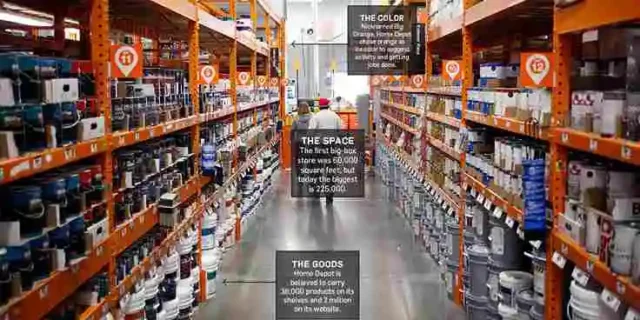Home Depot has long been a major player in the home improvement market, enjoying a steady sales streak that saw growth even during challenging times like the pandemic. However, recent developments show that the company is now facing some significant challenges. The once strong and robust sales have hit a screeching halt, and the company has reported a dismal quarter that reflects a broader pullback in consumer spending on home improvement projects. This article will explore the reasons behind this decline and what it means for the future of Home Depot and the home improvement chain industry.
A Sudden Shift in Consumer Behavior
Home Depot’s first quarter results were disappointing as the company saw its sales fell by 4.5% at stores that have been open for at least a year. This is a sharp contrast to the same stretch last year when the company was still riding high on the wave of pandemic-driven consumer spending. The outlook for the year is also not promising, with income decreased by 6.4% and revenue for the quarter slipping to $37.3 billion. This decline in sales can be attributed to several factors, including weather-related challenges like heavy rains in California and falling lumber prices that have dented the company’s sales. According to Home Depot CEO Ted Decker, this year is expected to be one of moderation, with sales expectations being revised downward to a decline of between 2% and 5% compared to the year prior.
The Changing Tide in the Home Improvement Market
The change in tide for Home Depot is significant, especially considering that the company was one of the big winners during the pandemic. Spending on homes became a priority for many families as Americans were suddenly living, working, and studying from home. But as life has started to return to some semblance of post-pandemic normalcy, the demand for home improvement projects has diminished. The money that was once earmarked for fixing and beautifying the home is now being spent on eating out, traveling, shopping, and other indulgences.
Decker addressed these changes during a call with analysts on Tuesday, where he noted that business from both DIY customers and professional contractors was less than expected. This is partly due to higher interest rates and inflation taking a toll on consumers’ ability to take on large home improvement projects. Instead, consumers are opting for smaller, more manageable projects.
Projects Are Getting Smaller
One of the key observations from Home Depot’s recent quarter is that while projects are still strong, the size of these projects is getting smaller. Decker mentioned during the call that projects are either being deferred or broken down into chunks. For instance, instead of renovating an entire room or entire basement all at once, consumers are now taking on these tasks in smaller chunks. This shift impacts the number of items per basket and the overall activity at Home Depot stores.
Neil Saunders, a Managing Director with Global Data and a retail expert, commented on this trend, noting that Home Depot’s slowing sales pace is a sign of an underlying softness in the economy. This softness is also reflected in the housing market, where slowing activity due to higher interest rates is deterring some people from either refinancing their mortgages to move or taking out new mortgages for their first homes. This has had a chilling knock-on effect on the home improvement category.
A Pullback on Big-Ticket Purchases
Another significant trend observed by Home Depot is the pullback on big-ticket appliances. Consumers are becoming more cautious with their spending, particularly on bigger and more expensive items. Billy Bastek, Home Depot’s executive vice president of merchandising, noted that the continuation of this trend from the fourth quarter has seen demand soften in categories like flooring, kitchen, and bath. After years of unprecedented demand, there’s now a noticeable softness in big-ticket discretionary categories such as patio, grills, and appliances. This is likely due to the deferral of these single item purchases as consumers navigate this transitional period.
A Cautious Consumer
As we continue through this transitional period, Home Depot is seeing a shift in consumer behavior. People are no longer spending as much time at home as they did in previous years. Decker pointed out that the company is now dealing with a more cautious consumer, which aligns with the buildup of inflation and price sensitivity, particularly with respect to those bigger ticket discretionary items. Despite these challenges, Decker remains optimistic that Home Depot will navigate this transition period successfully.
The Bigger Picture
The current situation at Home Depot is not unique. Other retailers like Target (CBDY) and Walmart (WMT) are also set to report their earnings this week, which will provide further insight into the overall sentiment among US consumers. This broader economic picture will help us understand whether this pullback in home improvement projects is a temporary blip or a sign of longer-term changes in consumer behavior.
Conclusion
In conclusion, Home Depot is facing a challenging period as it navigates a significant shift in consumer spending habits. The company’s once robust sales streak has come to a screeching halt, and the dismal quarter reflects the broader pullback on home improvement projects. With higher interest rates, inflation, and a cautious consumer, Home Depot is adapting to a new reality. However, with its strong market position and ability to adjust to changing conditions, Home Depot may still find a way to thrive in this evolving landscape.
If you love staying updated with the latest in fashion, travel, tech, sports, and gadgets, be sure to follow news feed nation. Don’t miss out on any updates—get the freshest news and trends delivered right to you!





























